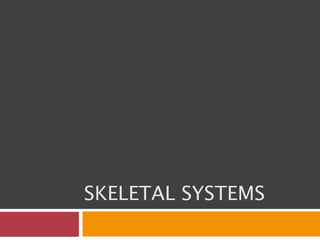
Skeletal System Introduction
- 2. Two Major Sections of the Skeleton 2 Axial Skeleton Used to protect fragile tissue that is held underneath Vertebrae, ribs, skull sternum Appendicular Skeleton These bones allow for movement Bones of the limbs
- 3. Variations of Bones 3 Total number of bones vary by species and even within a species Example: Horse – 205 bones Dog – average - 320 bones Some dogs are born with short tails and others have long tails which change the number of vertebrate present Dewclaws some are born with some are born without changing the number of digits present
- 4. Bones of the Axial Skeleton 4 Cranium Made mostly of flat bones (50 bones in a dog) Shape varies between species and breed Used for protection of the brain and other sense organs (taste, smell, hearing, sight,) Lower jaw – mandible, is moveable allowing an animal to obtain and chew food
- 5. Bones of the Axial Skeleton 5 The Vertebral Column Extends the length of the body from the skull Protects the spinal cord and allows for movement Anatomy of the Vertebral Disk Covered with bony arch - protects spinal cord Intervertebral disks can be found between vertebrae. add cushion between the disks (not found between C1 and C2)
- 6. Bones of the Axial Skeleton 6 The Vertebral Column Broken down into anatomical divisions Cervical(7) Thoratic (13) Lumbar (7) Sacrum (3) Coccygeal (14-23)
- 7. Bones of the Axial Skeleton 7 The Vertebral Column Cervical Vertebrae – neck Mammals have 7 Cervical Vertebrae C1 – Atlas – allows for up and down movement of head C2 – Axis – allows for side to side movement Thoracic Vertebrae – have attached ribs Help to protect the heart and lungs, allow for respiration
- 8. Bones of the Axial Skeleton 8 The Vertebral Column Lumbar Vertebrae – lower back between thoracic vertebra and pelvis Flexes and extends as an animal moves Provide support for organs in the abdomen Sacrum Vertebrae Fuse with the pelvis allowing support of the hind end of the animal
- 9. Bones of the Axial Skeleton 9 The Vertebral Column Coccygeal Vertebrae – Tail Vary by species and within the species Dogs typically have 20 Coccygeal vertebrae but can range from 6-23!
- 10. Bones of the Axial Skeleton 10 10/13/10
- 11. Create it! 11 Congrats…you have graduated from the school of vertebral engineering! Lets put that education to good use!
- 12. Bone of the Axial Skeleton 12 Cranial – PECTORAL LIMBS Scapula Humerus Radius Ulna Carpus Metacarpal Phlanges
- 13. Bones of the Appendicular 13 Scapula Joins the humerus through a shallow ball and socket joint. Flat bone with a spine to attach tendons and ligaments
- 14. Bones of the Appendicular 14 Humerus Upperbone of the forelimb. Connects scapula to the elbow
- 15. Bones of the Appendicular 15 Radius and Ulna - Forearm Ulna runs to the point of the elbow and accepts the end of the humerus. Radius closely connects to the ulna and forms the remainder of the elbow joint. The elbow joint is a hinge joint and the reason that we can twist our forearm is because of the movement between the radius and ulna, not the elbow joint.
- 16. Bones of the Appendicular 16 Carpus - Wrist Radiusand ulna continue to the carpus. Group of bones arranged in two rows. Number of bones vary among species. Dog –7 Ruminants – 6 Horse – 7 or 8
- 17. Bones of the Appendicular 17 Metacarpus - Hand Long Bones Lots of differences in species. Dogs and cats have four long and one much smaller one (dewclaw) Horses have only one major bone, corresponds to the third one in other species, but has two smaller ones as well. Ruminants only have one very large metacarpal bone. As the ruminant embryo develops, the third and fourth one fuse together.
- 18. Bones of the Appendicular 18 Phalanges – fingers and toes Number of toes corresponds to the number of metacarpal bones. Singular form is phalanx. The last phalanx is covered by the nail or hoof.
- 19. Bones of the Appendicular 19 Caudal End – PELVIC LIMBS: Pelvis Femur Tibia Fibula Tarsus Metatarsus Phalanges
- 20. Bones of the Appendicular 20 Pelvis 3 fused bones. Pubis Ischium Ilium Sacrum supports the pelvis. Connection can be damaged, and may split away. Pelvis is made of two halves. Each half divides into regions: ilium, ischium, pubis. Ilium joins to the sacrum.
- 21. Pelvis 21 10/13/10
- 22. Bones of the Appendicular 22 Femur – Leg Bone Ball and socket joint to the pelvis. Goes to the knee.
- 23. Bones of the Appendicular 23 Patella – Knee Cap
- 24. Bones of the Appendicular 24 Tibia and Fibula Similar to Ulna and Radius in forearm
- 25. Bones of the Appendicular 25 Tarsus - Ankle
- 26. Bones of the Appendicular 26 Metatarsus – Top of foot
- 27. Bones of the Appendicular 27 Phalanges - Toes
Notas do Editor
- \n
- \n
- \n
- \n
- \n
- \n
- \n
- \n
- \n
- \n
- \n
- \n
- \n
- \n
- \n
- \n
- \n
- \n
- \n
- \n
- \n
- \n
- \n
- \n
- \n
- \n
- \n